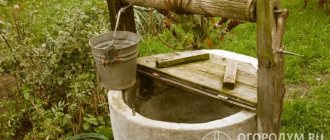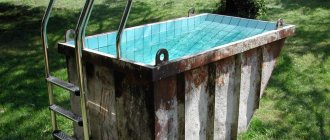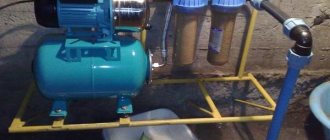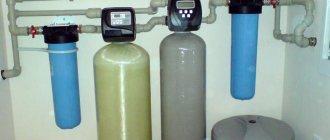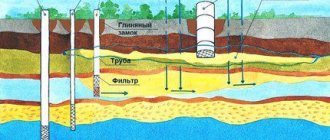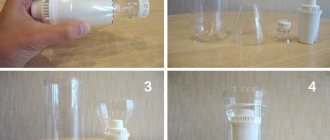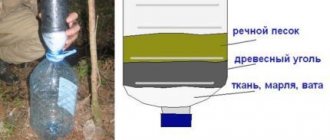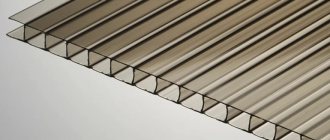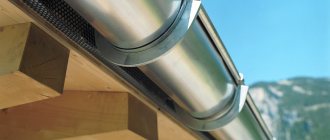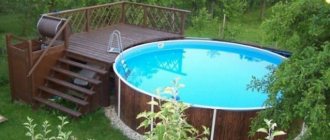Any artificial pond in a country house needs periodic water purification, especially when it comes to swimming pools. Unwanted living creatures in a garden pond and debris in the form of fluff and pollen are to some extent regulated by the population itself - plants, fish, if any, microscopic crustaceans. But a swimming pool, and even an outdoor one, has to be cleaned independently and much more often.
Cleansing methods can be somewhat roughly divided into 3 groups. Methods must be combined to obtain a good result. For example, mechanical methods based on the use of filters are recommended to be used constantly, and chemical methods are recommended in cases where there is severe contamination or the pool needs to be disinfected.
Mechanical methods
These include all manual devices and devices that are used to remove mechanical debris of any size and unwanted impurities. Cleaning using hand tools is carried out once every 2–3 days, it does not take much time:
- brush – used to remove stains and accumulations of small debris on the surface of the water, including fluff, plant stems and other things;
- garden net - it is even more suitable for collecting leaves, in addition, it allows you to collect foam;
- a special cleaning device (skimmer) - the principle of operation resembles a vacuum cleaner. It is equipped with a brush that collects small mechanical debris and removes it from the surface of the water. A mounted skimmer is often used for swimming pools, and a floating pond skimmer is often used for artificial reservoirs. Pool owners often prefer intex pool skimmers.
Read about skimmers for Intex pools at this link.
In the photo, do-it-yourself methods for cleaning pool water:
Large mechanical debris is removed regardless of how else the pond is cleaned. And filters are used to remove mechanical suspensions. The use of the latter involves installing a pump. The device must be operated for at least 6 hours to obtain a good result.
Proper care of an outdoor pool
You have to constantly take care of any artificial reservoir located in the open air. Even with an awning, leaves, branches, dust and other debris still get into the water during swimming.
To reduce the frequency of complete water changes, owners of such reservoirs need to follow basic care rules :
- install a sand filter;
- daily clean the surface of the water from large organic debris using a brush or net;
- regularly (once every two weeks) treat the water with chemicals to prevent flowering;
- during breaks between bathing, cover with an awning, for example made of PVC film;
- drain and close for the winter.
If we are talking about an inflatable children's "paddling pool", then the water in it needs to be changed at least once a week, while thoroughly washing all the internal surfaces.
Types of filters
To purify water, including in children's pools, several types of filters are offered:
- Sand is the most affordable option, ensuring the removal of mechanical particles up to 20 microns in size, including removing excess iron impurities from water. The working medium is quartz sand - a completely neutral substance. The main disadvantage of the filter is the need to clean it weekly: the device is washed under running water with good pressure, which is not always possible in the countryside. Sand filters are recommended for use in small reservoirs, like inflatable ones, where the water changes frequently. Here you will find a description and instructions for the bestway pool sand filter.
- Cartridge - is a system of cartridges that retain particles up to 10 microns. The filter is more efficient and durable, but costs more.
The cartridge filter also has to be washed, although less often.
Types of cartridges:
- They produce disposable cartridges for swimming pools. After use they are simply disposed of.
- Diatomaceous earth - the filter layer is diatomaceous earth - crushed plankton shells. Provides the most effective cleaning, removing particles up to 3 microns in size. However, it has a low resource and cannot be restored: it has to be replaced up to 4 times per year, which is quite expensive.
Find out what a manual pool bottom vacuum cleaner is used for here.
Cleaning the walls
If the time has come to clean the pool of greenery, dried black and limescale, you must use special preparations that will help clean the tank quickly and efficiently.
In addition, you need to decide on the method of cleaning the walls, which can be:
- chemical;
- mechanical;
- electrophysical.
During the course of work, all these methods can be combined; it is not necessary to use only one. This tandem will make it possible to perform better cleaning and get rid of more dirt and germs. But before you start washing the walls, you need to remove all large and small debris from the water. And only after draining the water can you start working.
Chemical methods
Chemicals involve purifying water from biologically and chemically active contaminants - bacteria, algae, fat, etc. In addition, only chemicals control and maintain the normal acid-base balance - pH at 7–7.4.
A pond, especially a small one, is very well heated by the sun. The latter benefits not only bathers, but also creates an excellent environment for the proliferation of pathogenic bacteria. To eliminate them and prevent their development, it is necessary to use drugs that contain a strong oxidizing agent.
Chlorine disinfection
Products with chlorine - chlorine gas, bleach, hypochlorite salts, dichloranthin, sometimes even bleach, and so on. The disadvantage is a specific and rather strong smell. Special chlorine tablets for swimming pools are easy to use. Also pay attention to the sand filter with chlorine generator for the intex pool.
Chlorine preparations are quite affordable and are used both for long-term disinfection and instant disinfection - shock chlorine. Price – 600 rub.
Chlorination is not performed if one of the family members has an allergic reaction to halogens. For everyone else, the drugs are harmless, and the smell, due to the large area of water, disappears quickly.
Preparations with bromine
Preparations with bromine - dibromantine, for example. There is no smell, the effect of the product is approximately the same. If you are allergic to bromine, which is also quite common, the drug is not used.
Disinfection with active oxygen
Preparations with active oxygen - or cavitation water purification. Its essence boils down to the initiation of oxidation reactions, but not with the help of halogen ions, as in the previous case, but with the participation of OH radicals and ozone. The effectiveness of the technology is explained by the fact that the drug itself acts as a starting point, while further oxidation is carried out due to oxygen dissolved in water. An undoubted advantage is the low concentration of the drug, guaranteed absence of allergic reactions. The downside is the cost. Sometimes the price reaches 5,000 rubles for a set of cleaning chemicals.
Perhydrol
Quite often, small pools at dachas are treated with a 37% perhydrol solution. The drug's action resembles something between chlorine and active oxygen: in terms of its chemical effect it is close to the cavitation mechanism, but in terms of concentration it is close to chlorine, since it is a participant and not a catalyst in the reaction.
Price – 1200 rub.
Coagulants and flocculants
In addition to the need to destroy bacteria and algae, pool owners are faced with another problem: large organic molecules, fatty, for example, which a mechanical filter cannot remove, but which contribute to the rapid accumulation of dirt and serve as an excellent breeding ground for both bacteria and algae. The link describes a method for cleaning a pool with hydrogen peroxide.
This problem is solved using the process of coagulation - combining small suspended particles into large ones. Preparations of this kind are called coagulants or flocculants. When added to water, the active particles that make up the drug envelop the smallest organic and inorganic particles and hold them. When a critical mass is formed, the compound forms a flocculent sediment and collects at the bottom. After the process is completed, all that remains is to remove this sediment. Read about purifying pool water with copper sulfate in this article.
The most famous today is Aquadoctor. The drug is added directly to the water, preferably before filtration. During treatment, the pool and filter system must be inactive. The sediment is then collected and the water is filtered mechanically.
What do you need to get rid of?
Every day, a variety of contaminants enter the pool from the environment with precipitation or wind (if the pool is open) or through windows, doors and the ventilation system (if it is closed). In addition, particles of keratinized skin, decorative cosmetics, foundation or tanning creams are a breeding ground for bacteria. Against this background, the water quickly loses transparency, becomes cloudy and has a green color due to the presence of algae. For this reason, microbes multiply, and a white coating appears on the walls of the pool, which looks unpleasant. You should get rid of this using means, of which there are a large number.
Electrophysical methods
These methods belong to the instrumental category: to clean the pool, it is not drugs that are needed, but equipment. Their cost, of course, is higher, but they guarantee the preservation of the original composition of the water.
Ozone
Ozone is a strong oxidizing agent that destroys absolutely all microorganisms, ensuring sterile purity of water.
Ozonation is rarely used in summer cottages, as it requires the installation of rather complex equipment and communications.
Ultraviolet irradiation
Ultraviolet irradiation is a more accessible method based on treating a reservoir with ultraviolet radiation. For this purpose, special quartz lamps are used, which disinfect the water. Ultraviolet does not have a prolonged effect, unlike disinfection with chlorine or ozonation. The performance of quartz lamps is greatly influenced by the degree of water transparency. Therefore, ultraviolet irradiation can be carried out only after removing mechanical debris.
Water ionization
Ionization – the essence is the saturation of the water in the pool with silver or copper ions. The latter are produced by an electrolytic installation - an ionizer. Metal ions remain active for several weeks, disinfect water, destroying bacteria, and precipitate heavy metals.
Household ionizers are designed for pool volumes up to 60 cubic meters.
A sand filter must be used in parallel with the ionizer. The operation of the device becomes significantly more difficult if the water is not cleared of small mechanical suspensions and debris.
How to remove plaque and rust
Cleaning the bowl includes removing yellow stains, limescale and rust. For this purpose, specialized solutions are used that do not negatively affect the finish, equipment and bathers. To work you will need:
- an alkali-based cleaner, it is better to choose it in powder form (it copes well with dirt and limescale, and is suitable for caring for pools made of film, mosaic, composite, tile);
- A hydrochloric acid based cleaner that fights lime deposits.
The process of cleaning plaque and rust is as follows:
- Drain the water.
- Clean the tile joints using acid solutions and the walls using a stiff brush. This should be done immediately after draining the water. When using harsh chemicals, it is necessary to use various protective measures - rubber boots, gloves and safety glasses.
- Rinse the walls and drain the dirty water.
- Carry out preventive work to prevent the appearance of algae. A 1% solution of Algaecide is suitable for this.
Just like when cleaning a pool of greenery, it is necessary to backwash the filter, since lime deposits may still be there.
The best DIY comprehensive cleaning methods
Such a wide variety of methods is associated not only with the effectiveness or cost of the procedures, but also with the operating conditions of the pool. The material of the reservoir, the nature of the pool - outdoor or indoors, the number of users - all this affects the frequency of cleaning and the choice of products.
For outdoor pool
Such a body of water is the most vulnerable. Good heating by the sun provides an environment for bacteria, open space literally attracts mechanical debris, the accumulation of organic matter - the same plant debris, promotes the rapid proliferation of algae. Therefore, it requires comprehensive cleaning.
On the other hand, the pool is located in the open air, so such a danger as the accumulation of reaction products after chlorination, for example, does not exist here. Therefore, all methods are used to clean open reservoirs.
- A combination of mechanical filtration with some chemical or electrophysical methods, without chemistry, is mandatory. The most affordable are cartridge or sand filter and chlorination.
- It is advisable to periodically carry out cleaning using coagulants: this is the best means for removing protein and fatty molecules that serve as food for both microorganisms and algae.
- In an outdoor pool, you need to constantly check the acidity level. With normal values of 7–7.4, the risk of algae infection is minimal. If the indicator deviates, the risk increases. The adjustment is made by adding “pH-plus” and “pH-minus” preparations to the water, respectively.
- It is not recommended to use ultraviolet disinfection, since quartz lamps, like any electrical device, should not be left in the open air for a long time.
Cleaning without chlorine
Chlorination is a simple and effective procedure. The only contraindication is an allergic reaction to chlorine dissolved in water. In this case, any other chemical methods are used, always in combination with mechanical ones:
- bromination;
- preparations with active oxygen;
- treatment with perhydrol solution.
If the pool is located indoors, the best method is ultraviolet disinfection or ionization.
Chlorine-based chemicals
Such drugs remain popular due to their low cost and effectiveness. Disinfection of water with chlorine-based products (tablets, powders) occurs quickly. However, they are far from the best option. The reasons are a sharp, unpleasant odor of water, a possible allergic reaction. In addition, even a weak solution of chlorine preparations dries the skin, provokes irritation, and can also change the color of swimsuits and swimming trunks.
Help of drugs with bromine
This chemical element does not change the pH of the liquid, it is not allergenic, and does not irritate the skin and mucous membranes. However, bromine is effective against microorganisms and algae, and, like chlorine, removes organic contaminants. But it cannot cope with a large volume of work, so it is used together with a chemical “colleague”. The second disadvantage of products containing bromine is their higher price. These products are also produced in the form of powder and tablets.
Other drugs
It must be said that the simplest means do not always cope with their task. Therefore, owners have to consider other options.
If a lot of dirt has accumulated and the liquid is very cloudy, then it makes sense to use other means - coagulants and flocculants. These drugs are able to bind particles, after which they precipitate to the bottom of the pool. Such contaminants are collected with a vacuum cleaner. Examples - AquaDoctor, Aqualeon, Bayrol Quickflook Super, Chemoform Flokfix, Melspring Melpool DualFloc Bio, AquaSTART.
Algaecides are reagents that help cope with mold and algae and prevent their reappearance. Therefore, regular treatment of the pool with these preparations is protection against vegetation and the appearance of silt deposits. Popular algaecide preparations are Aqualand, Algitinn, Chemoform Alba Super K, Maxisan-algaecide, Super-Pul.
Complex preparations can be used for disinfection. Their bases are bromine, chlorine, and organic acids. True, their price is higher than that of simpler analogues: they often cost twice as much.
How to purify water in a swimming pool at the dacha
To purify water, two main methods are used - chemical and mechanical. The chemical method involves adding special substances that purify and disinfect water, and also stop the proliferation of microorganisms.
Ultraviolet light prevents bacteria and phytoplankton from multiplying in water.
The mechanical method is the use of various filters and devices that help not only purify the water, but also remove sediment from the walls of the pool. Filters can be:
- Mechanical. They remove impurities through a filter element. There are models combined with a transfer pump.
- Ultraviolet. The device is a flask containing a UV lamp. Ultraviolet light destroys bacteria and phytoplankton.
Both types of filters can be used simultaneously. In this case, the water is first disinfected with ultraviolet light and then filtered.
A special vacuum cleaner will help to cope with sediment on the bottom and walls. With its help, it will be easy for you to remove flakes that form during chemical treatment of water.
Skimmer for water purification.
Another device that will help the water stay clean is a skimmer. This device cleans the upper aqueous layer, which contains up to 80% of all microorganisms.
Third stage: collecting garbage with a vacuum cleaner
To do this, we need a homemade vacuum cleaner made from a plastic canister and a small piece of garden hose.
The top of the plastic canister needs to be cut off, and a hole needs to be drilled in the side wall so that the hose can be inserted.
With one hand we recess the container to create negative pressure in it, and with our left hand we move the hose along the bottom and collect debris.
Please note: it is advisable to perform the second and third stages several times in a row. This will remove as much dirt as possible.
